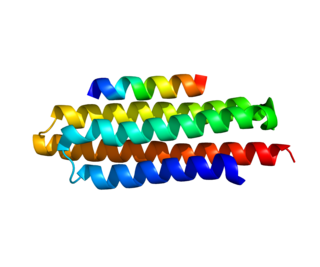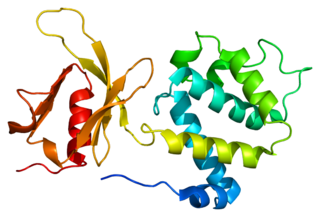Related Research Articles

In mammalian cells, vinculin is a membrane-cytoskeletal protein in focal adhesion plaques that is involved in linkage of integrin adhesion molecules to the actin cytoskeleton. Vinculin is a cytoskeletal protein associated with cell-cell and cell-matrix junctions, where it is thought to function as one of several interacting proteins involved in anchoring F-actin to the membrane.

Tyrosine-protein kinase ABL1 also known as ABL1 is a protein that, in humans, is encoded by the ABL1 gene located on chromosome 9. c-Abl is sometimes used to refer to the version of the gene found within the mammalian genome, while v-Abl refers to the viral gene, which was initially isolated from the Abelson murine leukemia virus.

In cell biology, focal adhesions are large macromolecular assemblies through which mechanical force and regulatory signals are transmitted between the extracellular matrix (ECM) and an interacting cell. More precisely, focal adhesions are the sub-cellular structures that mediate the regulatory effects of a cell in response to ECM adhesion.

Paxillin is a protein that in humans is encoded by the PXN gene. Paxillin is expressed at focal adhesions of non-striated cells and at costameres of striated muscle cells, and it functions to adhere cells to the extracellular matrix. Mutations in PXN as well as abnormal expression of paxillin protein has been implicated in the progression of various cancers.

The breakpoint cluster region protein (BCR) also known as renal carcinoma antigen NY-REN-26 is a protein that in humans is encoded by the BCR gene. BCR is one of the two genes in the BCR-ABL fusion protein, which is associated with the Philadelphia chromosome. Two transcript variants encoding different isoforms have been found for this gene.

Adapter molecule crk also known as proto-oncogene c-Crk is a protein that in humans is encoded by the CRK gene.

CD49d is an integrin alpha subunit. It makes up half of the α4β1 lymphocyte homing receptor.

PTK2 protein tyrosine kinase 2 (PTK2), also known as focal adhesion kinase (FAK), is a protein that, in humans, is encoded by the PTK2 gene. PTK2 is a focal adhesion-associated protein kinase involved in cellular adhesion and spreading processes. It has been shown that when FAK was blocked, breast cancer cells became less metastatic due to decreased mobility.

Dual specificity mitogen-activated protein kinase kinase 2 is an enzyme that in humans is encoded by the MAP2K2 gene. It is more commonly known as MEK2, but has many alternative names including CFC4, MKK2, MAPKK2 and PRKMK2.

Crk-like protein is a protein that in humans is encoded by the CRKL gene.

Phosphatidylinositol 3-kinase regulatory subunit beta is an enzyme that in humans is encoded by the PIK3R2 gene.

Protein tyrosine kinase 2 beta is an enzyme that in humans is encoded by the PTK2B gene.

Rap guanine nucleotide exchange factor 1 is a protein that in humans is encoded by the RAPGEF1 gene.

Phosphatidylinositol-4,5-bisphosphate 3-kinase catalytic subunit gamma isoform is an enzyme that in humans is encoded by the PIK3CG gene.

Breast cancer anti-estrogen resistance protein 1 is a protein that in humans is encoded by the BCAR1 gene.

Vasodilator-stimulated phosphoprotein is a protein that in humans is encoded by the VASP gene.

Tyrosine-protein phosphatase non-receptor type 12 is an enzyme that in humans is encoded by the PTPN12 gene.

Glucocorticoid receptor DNA-binding factor 1 is a protein that in humans is encoded by the GRLF1 gene.

Tensin-1 is a protein that in humans is encoded by the TNS1 gene.

Talin-1 is a protein that in humans is encoded by the TLN1 gene. Talin-1 is ubiquitously expressed, and is localized to costamere structures in cardiac and skeletal muscle cells, and to focal adhesions in smooth muscle and non-muscle cells. Talin-1 functions to mediate cell-cell adhesion via the linkage of integrins to the actin cytoskeleton and in the activation of integrins. Altered expression of talin-1 has been observed in patients with heart failure, however no mutations in TLN1 have been linked with specific diseases.
References
- ↑ "Ravi Salgia, MD, PhD, Joins City of Hope". ascopost.com. Retrieved 8 September 2019.
- ↑ "Acclaimed oncologist/researcher Ravi Salgia joins City of Hope as chair of medical oncology". www.cityofhope.org. Retrieved 9 September 2019.
- ↑ Salgia, R.; Avraham, S.; Pisick, E.; Li, J. L.; Raja, S.; Greenfield, E. A.; Sattler, M.; Avraham, H.; Griffin, J. D. (6 December 1996). "The related adhesion focal tyrosine kinase forms a complex with paxillin in hematopoietic cells". The Journal of Biological Chemistry. 271 (49): 31222–31226. doi: 10.1074/jbc.271.49.31222 . ISSN 0021-9258. PMID 8940124.
- ↑ Salgia, R.; Pisick, E.; Sattler, M.; Li, J. L.; Uemura, N.; Wong, W. K.; Burky, S. A.; Hirai, H.; Chen, L. B. (11 October 1996). "p130CAS forms a signaling complex with the adapter protein CRKL in hematopoietic cells transformed by the BCR/ABL oncogene". The Journal of Biological Chemistry. 271 (41): 25198–25203. doi: 10.1074/jbc.271.41.25198 . ISSN 0021-9258. PMID 8810278.
- ↑ Salgia, R.; Sattler, M.; Pisick, E.; Li, J. L.; Griffin, J. D. (February 1996). "p210BCR/ABL induces formation of complexes containing focal adhesion proteins and the protooncogene product p120c-Cbl". Experimental Hematology. 24 (2): 310–313. ISSN 0301-472X. PMID 8641358.
- ↑ Okuda, K.; Matulonis, U.; Salgia, R.; Kanakura, Y.; Druker, B.; Griffin, J. D. (October 1994). "Factor independence of human myeloid leukemia cell lines is associated with increased phosphorylation of the proto-oncogene Raf-1". Experimental Hematology. 22 (11): 1111–1117. ISSN 0301-472X. PMID 7925778.
- ↑ Salgia, R.; Li, J. L.; Lo, S. H.; Brunkhorst, B.; Kansas, G. S.; Sobhany, E. S.; Sun, Y.; Pisick, E.; Hallek, M. (10 March 1995). "Molecular cloning of human paxillin, a focal adhesion protein phosphorylated by P210BCR/ABL". The Journal of Biological Chemistry. 270 (10): 5039–5047. doi: 10.1074/jbc.270.10.5039 . ISSN 0021-9258. PMID 7534286.
- ↑ pubmeddev. "ravi Salgia - PubMed - NCBI". www.ncbi.nlm.nih.gov. Retrieved 9 September 2019.
- ↑ "Ravi Salgia, M.D., Ph.D., Chair and Professor of City of Hope's Department of Medical Oncology & Therapeutics Research". www.cityofhope.org. Retrieved 9 September 2019.
- ↑ "Acclaimed Oncologist/Researcher Ravi Salgia Joins City of Hope as Chair of Medical Oncology". www.businesswire.com. 13 January 2016. Retrieved 9 September 2019.